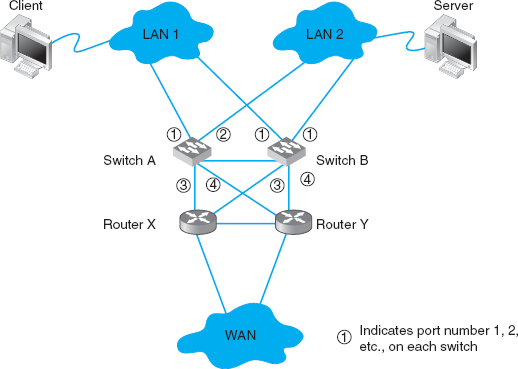APPENDIX B
SPANNING TREE PROTOCOL
Redundancy is an important element of good network design (see Chapter 12). Redundant circuits and devices mean that the network can continue to operate even if one circuit or device fails. For example, if a device has a 99.99 percent reliability, there is a.01 percent chance of failing. This means on average that the device will fail for about one hour per year. With two devices, the reliability increases to 99.9999 percent, or less than one minute of expected downtime per year.
Figure B.1 shows a common redundant network design. Two LAN segments (LAN 1 and LAN 2) are connected to two separate switches (A and B), that are in turn connected to two separate routers (X and Y) connected to the corporate WAN. Each switch has 4 ports; port 1 on switch A connects to LAN 1, port 2 connects to LAN 2, port 3 connects to router X, and port 4 connects to router Y. In this way, both LAN 1 and LAN 2 can continue to operate and send messages to and from each other and the WAN if any one circuit or device fails. For example, if switch A fails, all traffic into LAN 1 can still flow through switch B. Likewise, if router X fails, if the circuit from switch A to router X fails, or if port 3 on switch A fails, then traffic can flow through switch A to router Y and then into the WAN.

FIGURE B.1 Network design with redundant circuits and devices. LAN = local area network; ...
Get Business Data Communications and Networking, Eleventh Edition now with the O’Reilly learning platform.
O’Reilly members experience books, live events, courses curated by job role, and more from O’Reilly and nearly 200 top publishers.

